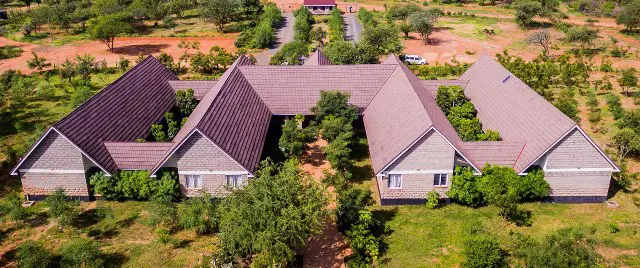The cost of building material is skyrocketing with developers forced to come up with innovative solutions. Lukenya University is being built using soil blocks.
Demand for education has seen unprecedented increase in the number of students seeking university education. However the number of universities available cannot match the number of students leaving secondary schools each year. The cost of expanding existing universities or even building new ones continue to be exorbitantly high.
But an emerging method of using low cost building material could be the best way of addressing the high cost of construction. Lukenya University is leading the way in this front. Nestled in Makueni County near the Athi river and with a total of over 400 students, Lukenya University has embraced green building techniques in its quest to align itself to nature.
The school has been constructed using hydaform blocks in a bid to reduce construction cost. The Hydraform Interlocking Soil Block (hydraform block) is an interlocking earth block used in many African countries for construction purposes. The hydraform block is made from soil cement which is a mixture of soil, cement and water, and is hydraulically compressed to form a high quality interlocking soil block.
Soil from the building site can be used to manufacture building blocks. The Hydraform compressed earth block is very popular due to the cost savings that are involved during the construction process as only around 30% of the structure requires mortar between the blocks.
While various materials for affordable housing exist, Hydraform blocks have proved to be much cheaper and readily available.
“Hydraform Interlocking Blocks save on mortar and plaster cost, you don’t use mortar to bond it together, it has tongue and groove joints that form interlocking masonry wall. When it comes to plaster you also save since the interlocking wall doesn’t have big holes that need to be covered with mortar when plastering,” says Sylvia Kasanga director at Sycum Solutions the architectural firm being the design of Lukenya University.
“Another facet is the excellent thermal properties of the blocks. Makueni is a hot area and we needed building material that could embrace the weather changes of the area,” he adds.
Also with Hydraform Blocks there is no cutting of trees as in the case of burnt bricks thus environment friendly. Additionally, you also have an option of not plastering, because the wall looks beautiful even without plaster on it.
And due to the interlocking nature of the stabilized soil block, unskilled labour can be utilised in construction thereby empowering rural communities and creating jobs. And this is what Lukenya University has done to the Community surrounding it.Young people have benefitted immensely by being trained on how to make and use the hydaform blocks.
“This University has been a blessing to the community here. Apart from bringing the university education closer to the people, the project has also been a source of employment,” she says.
Established in 2015, the university is set to be constructed in phases. “The Lukenya university project is an ongoing one. Construction will be done in phases depending on the number of students that we receive annually,” Sylvia explains.
If things go as plans in six or seven years to come, Lukenya will be a fully fledge university with several class rooms and office blocks.
“In the final stages of construction, Lukenya University will have a big modern library, a graduation square, an amphitheatre and a media centre among others. With these developments we will be at a position to host over 6000 students,” she says.
In the bid to go entirely green, Lukenya University is looking to harness sunlight in the area to produce electricity. In this regard they are in talks with an international solar company to install solar panels that will be used as source of power.
While the design plan has fully embraced the use of soil blocks, this was not the initial construction material. As Sylvia says, the first building material for the university was stones. However, the move was not sustainable and posed several challenges.
Main among them is the lack of quarries in Kibwezi. Then there was the issue of road infrastructure in the area. Sylvia says when construction of the institution started there were literally no roads in the area. Another issue was the lack of artisans in the area. This forced the importation of workers from other places to Kibwezi.
But one thing that stands out is the affordability of soil blocks compared to other construction material. According to Sylvia, the soil blocks were chosen after extensive study of other available material.
“In my own opinion, nothing can beat the soil blocks in terms of cost and thermal properties,” she asserts. Lukenya University has one hydraform that is used to make about 1000 blocks a day.
The introduction of Hydraform machines in Kenya is a government initiative aimed at helping Kenyans builds affordable housing in a country that is experiencing housing shortage. Under this initiative, one or two hydraform machines were given to each county across the country. However, the initiative is being used in rural areas while in urban areas it is rare to see such a machine at work.
The issue of affordable housing in Kenya continues to be a contentious issue. With many such houses going for over Ksh1m, questions are being raised on how affordable they are especially considering that majority of Kenyans earn less than Ksh30,000 a month.

A Nice Article. Thank you.